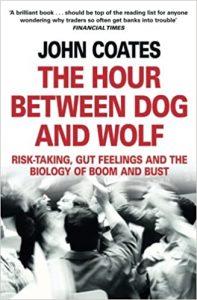My lockdown days have become filled with Zoom meetings at the expense of reading on tubes and trains. I’m definitely going to try to cut down on the online calls, which are exhausting (& I hope tech-land is working out why, and trying to fix it).
Meanwhile, I read a very good biography of Walter Gropius by Fiona MacCarthy, another of the wonderful Maigret novels, and also The Hour Between Dog and Wolf: risk taking, gut feelings, and the biology of boom and bust by John Coates.
It’s a really interesting book about the role biological/neurological responses in decision-making, applied to the financial market context. It will surprise nobody to learn that testosterone is one of the key players, generating bull markets (hah!) and excess risk-taking. “Traders are walking time bombs, and banks invariably light the fuse, dangling before them huge risk limits and bonus payments.” There seem some obvious regulatory interventions in the financial context eg ban bonus structures and mandate 50% female employees on trading floors. The book points out that at most 5% of traders are women, even though they outperform men over the long term.
The book braids together sections on the biology and sections tracking the various hormones and nervous impulses in a financial market boom. It’s a terrific read and super-clear. The author is a financial markets guy turned research scientist and having both sets of insights is illuminating.
The part that most interested me though – and that put me on to the book via an FT article about the impact of uncertainty on our health – was pondering what it means for a computer to think and make decisions when human decision-making is so firmly embodied, driven by our physical features, the way the chemicals in the blood stream and the nervous signals shape perception and emotion. The book I’ve now started (Economic Life in the Real World by Charles Stafford ) cites Antonio Damasio’s work in Descartes’ Error: people whose emotions are affected by brain injury are worse at making ‘rational’ decisions. Reason and emotion – involving biochemical and neurological phenomena – go hand in hand. Meanwhile, we are building AIs according to an idea of ‘reason’ modelled on homo economicus.

